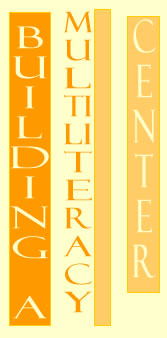

Course
Challenges
KHM: If the Multiliteracy Center and this instructor would work
together on this course again, would you make changes based on any challenges
you encountered?
DS: You know, I think, by and large, the course was very successful and resulted in websites that the non-profits were really happy with. And, really, several of their representatives were actually really pleased with their websites. But, we learned a lot in going through this, and it was the first time that each of us had worked this extensively with this particular format.
One of the challenges that we faced was that in each group, the bulk of the work tended to be done by one or two students. Whereas we wanted all of the students to experience, at least I was hoping all of the students would experience, the full spectrum of composing in digital environments -- that all of the students would be intensely involved in the design, the layout, the graphics, and all of that. I think in any class you're always going to get some students who are more committed to the course than others. I also felt that when push came to shove and when the overall architecture and the overall design of the site had to get done, it seemed like it fell to a few individuals to really make sure that it in fact was done and some of the students were playing more peripheral roles. So if we did it all over again, I think we would really ensure that everyone contributed more equally. Maybe we would have each individual student come up with a kind of mock-up design for each site. That would be one way to do it.
Another thing is that the sites weren't really done until the end of the class, and so the non-profits really only had a chance to respond to them when the course was over. That takes away from one of our goals, which is to meet the needs of an actual client who is trying to reach an actual audience. We built in deadlines throughout the semester so that, in theory, we asked that the sites be completed earlier in the semester so that the non-profits could look at them and give a response. And then the students could revise based on that response.
But
what happened is that we fell behind, students fell behind and the non-profits
couldn't really look at anything until the sites were done. And so, the
students were not able to get the rich response to their work that we
had hoped to get, and they were also not able to revise in the way that
we had hoped they would be able to. So we would probably make sure that
those deadlines were enforced and that students really did have a working
mock-up of their sites early enough in the term, so that they could get
a response.
Top | Next